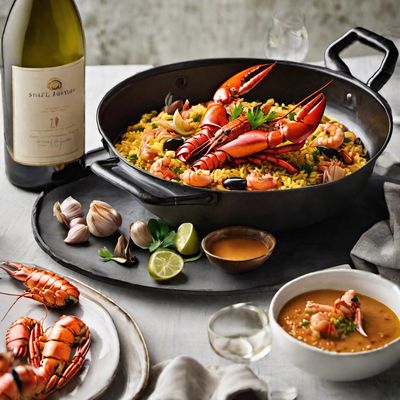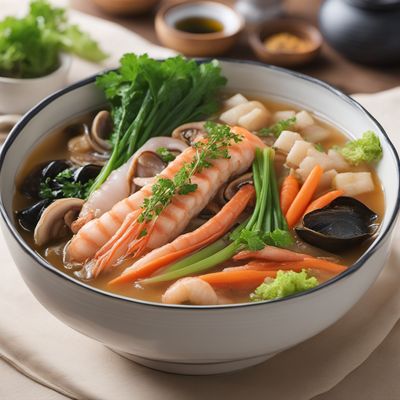
Ingredient
Scallop, great
Oceanic Delicacy: Discovering the Great Scallop
The great scallop is a bivalve mollusk found in the Atlantic Ocean, particularly along the eastern coast of North America. It has a distinctive fan-shaped shell, which houses its tender and sweet flesh. The meat of the scallop is firm yet delicate, with a slightly sweet and briny flavor. Its texture is buttery and smooth, making it a true delicacy.
Origins and history
Scallops have been enjoyed as a culinary delight for centuries. Native American tribes along the eastern coast of North America were known to harvest and consume scallops, recognizing their abundance and delectable taste. Over time, scallops gained popularity in European cuisines, particularly in France and Italy, where they are celebrated for their culinary versatility and delicate flavor. Today, the great scallop is highly regarded as a premium seafood ingredient.
Nutritional information
Great scallops are a good source of lean protein, omega-3 fatty acids, and essential minerals such as magnesium and potassium. They are also low in calories and fat, making them a healthy choice for seafood lovers. However, it is important to note that scallops are high in cholesterol, so moderation is advised for individuals with specific dietary restrictions.
Allergens
Scallops are a shellfish, and individuals with shellfish allergies should avoid consuming them. It is crucial to be cautious when dining out or purchasing scallops, as cross-contamination with other shellfish can occur.
How to select
When selecting great scallops, look for those that are fresh and have a mild, sweet aroma. The shells should be intact and free from cracks or chips. The flesh should be firm and slightly translucent, with no signs of discoloration or sliminess. Opt for scallops that are dry-packed or diver-caught, as they tend to have a better flavor and texture compared to those treated with preservatives or chemicals.
Storage recommendations
To maintain the freshness and quality of great scallops, it is best to store them in the refrigerator at temperatures below 40°F (4°C). Keep the scallops in a sealed container or wrapped tightly in plastic wrap to prevent exposure to air and moisture. Consume them within a day or two for optimal taste and texture.
How to produce
Producing great scallops requires specialized equipment and knowledge of shellfish farming or fishing. It is not feasible for amateurs to produce scallops at home. However, individuals can explore local seafood markets or connect with sustainable seafood suppliers to source fresh and responsibly harvested scallops.
Preparation tips
Great scallops can be prepared in various ways, including searing, grilling, baking, or poaching. They can be enjoyed as a standalone dish, seasoned with salt and pepper, or enhanced with complementary flavors like garlic, lemon, or herbs. Scallops can also be incorporated into pasta dishes, risottos, or stir-fries, adding a touch of elegance and seafood goodness.
Culinary uses
Great scallops are highly prized in the culinary world and are commonly used in dishes such as scallop ceviche, scallop risotto, or seared scallops with a citrus glaze. They are also a popular ingredient in sushi and sashimi preparations. Additionally, scallops can be used to enhance the flavors of soups, stews, or seafood chowders.
Availability
Great scallops are commonly found in the Atlantic Ocean, particularly along the eastern coast of North America. They are harvested in countries such as the United States, Canada, and Japan. However, they can also be found in other regions where scallop farming or fishing is practiced.
More ingredients from this category

Scallop, new zealand
The Ocean's Delicacy: Discovering the Flavors of New Zealand Scallops

Scallop, australian
Ocean Gems: Discover the Exquisite Australian Scallops

Scallop, queen
The Regal Delicacy of Queen Scallops

Scallop, giant pacific
The Ocean's Delicacy: Unveiling the Majesty of Giant Pacific Scallops

Scallop, bay
The Ocean's Delicacy

Yesso scallop
The Ocean's Delicacy

Scallop, sea
The Jewel of the Ocean
Recipes using Scallop, great » Browse all

Haute Cuisine Hot Pot
Elevated Hot Pot: A Gourmet Twist on a Chinese Classic

Cau Cau de Conchas with Aji Amarillo Sauce
Peruvian Delight: Scrumptious Cau Cau de Conchas with a Spicy Twist

Haute Cuisine Paella
Elevating the Classic Spanish Paella to Haute Cuisine Perfection

Japanese-style Paella
Sakura Paella: A Fusion of Spanish and Japanese Flavors

Jiangsu-style Spicy Seafood Pizza
Fiery Fusion: Jiangsu-style Spicy Seafood Pizza

Linguine with Seafood Medley
Mediterranean Delight: Linguine with a Seafood Symphony

Canadian Chinese-style Seafood Noodle Soup
Savoury Seafood Delight: Canadian Chinese-style Mohinga

Maritime Seafood Corollo
Oceanic Delight: Maritime Seafood Corollo

Maritime-style Seafood Pasta
Oceanic Delight: Maritime-style Seafood Pasta

Tianjin-style Seafood Cataplana
Tianjin's Flavors Unite: A Seafood Cataplana Delight

Nouvelle Cuisine Hot Pot
Elevated Hot Pot Delight

Japanese-style Seafood Hot Pot
Umami Delight: Japanese Seafood Hot Pot